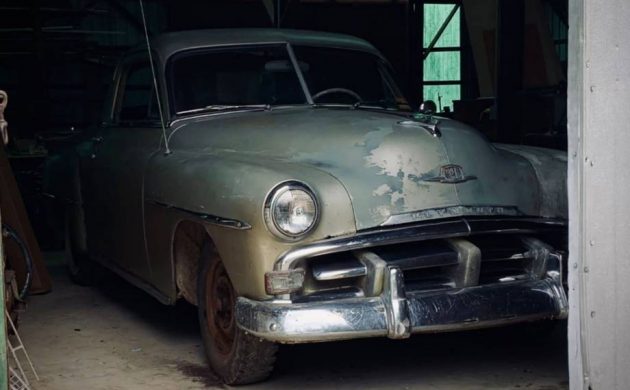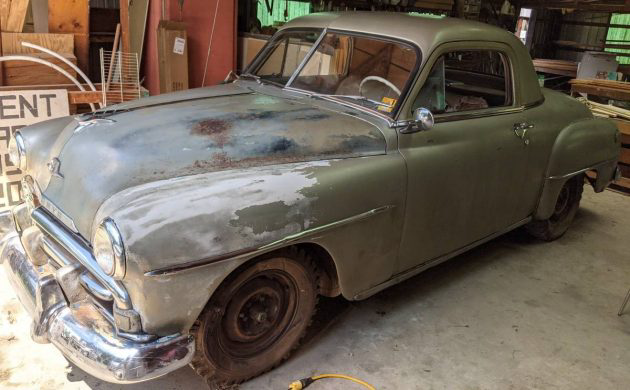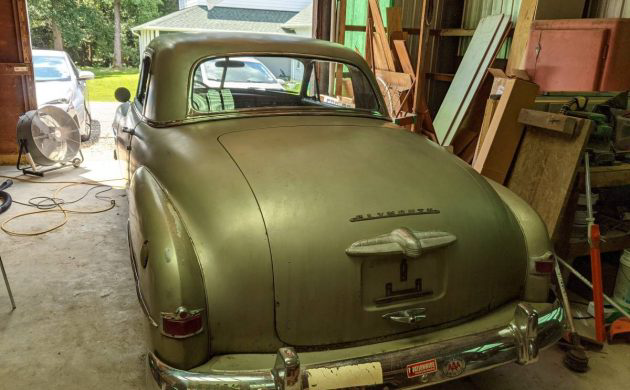Affordable Project: 1951 Plymouth Concord Business Coupe
Some models are renowned for their longevity, while others can be a “blink and you’ll miss it” proposition. The Plymouth Concord falls into the latter category, with Plymouth only producing the car for two model years. The 1951 Business Coupe is the rarest of the breed, and that is what is hiding in this barn. It is a project that stalled before it could start, so potential buyers won’t be faced with potentially rectifying someone else’s mistakes. The Concord is located in Williamsburg, Virginia, and has been listed for sale here on Craigslist. The owner has set the sale price at a very affordable $3,500. I have to say a big thank you to Barn Finder Gunter K for spotting this Plymouth for us.
The first thing that is worth noting with this Plymouth is that it does appear to be complete. All of the external trim is intact, except for the hubcaps, and the glass seems to be in remarkable condition for a vehicle of this age. The paint shows years of deterioration, and you have to search carefully to discover any traces of its original Sherwood Green that isn’t severely faded. However, that is only an inconvenience because the buyer will almost certainly treat the car to a repaint as part of the restoration process. There is also some rust to consider, but it doesn’t appear to be extensive. The owner mentions its presence in the passenger side rocker and the front floors, but I’ve also spotted some small areas in the lower rear fenders and the trunk pan. The Concord may have only remained in production for two years, but the correct steel to address these problems is pretty easy to find. He doesn’t mention any issues with the frame, which suggests that the Concord is structurally sound. Overall, whipping the body into shape looks no more complicated than with any other classic of this age.
As with the exterior, this Concord’s interior is essentially complete. Once again, it will require some work if it is to present at its best. This is where a versatile owner could hit their straps in this project. It features a lot of painted surfaces, along with trim pieces and a dash that should be easy to dismantle. If the buyer strips the interior and applies new paint, that will profoundly impact its appearance. The wheel is a prime candidate for restoration in a home workshop, while new trim would be limited to little more than a seatcover, door trims, and a headliner. A person who is good with their hands and has an eye for detail could whip this interior into shape without spending a fortune. When we finally reach the question of this car’s potential value, that could prove to be vitally important.
Buyers weren’t drowned with drivetrain choices when they purchased their new 1951 Concord because if you didn’t want the 217.8ci flathead six-cylinder engine, the alternative was to walk. Initially, Plymouth only offered a 3-speed manual transmission, but they did introduce an optional overdrive later in 1951. This flathead would’ve produced 97hp when new, allowing the Business Coupe to stroll down the ¼ mile in 21.4 seconds. The car doesn’t run, and the owner has removed the carburetor as he intended to rebuild it. This process stalled, and he has no idea about the state of the engine itself. If it is beyond help, that might not be all bad news. He includes a 230ci flathead six in the sale, which could serve as a replacement if the original proves to be only good for the scrapheap. There are also a few new components to help the buyer get the car running again. They include spark plugs, plug wires, an ignition coil, distributor cap, points, an oil pan gasket, and an ignition barrel. There is also a rebuild kit for the carburetor and the always invaluable Repair Manual.
The 1951 model year was the first for the Concord, and Plymouth produced 139,914 examples across all body styles. Of these, a mere 14,255 were the Business Coupe, which makes them a relatively rare beast. However, as we’ve seen in the past, rarity doesn’t necessarily equate to high potential values. They don’t come onto the market often, but when they do, a spotless example will struggle to reach far beyond $15,000. That means that the person who tackles this restoration will probably need to be willing to undertake most of the work themselves if it is to remain financially viable. Could you be that person?
Auctions Ending Soon
 2006 Ford Mustang Saleen S281 SCBid Now17 hours$15,000
2006 Ford Mustang Saleen S281 SCBid Now17 hours$15,000
 2002 Subaru Impreza WRXBid Now3 days$100
2002 Subaru Impreza WRXBid Now3 days$100
 1975 Chevrolet Corvette ConvertibleBid Now3 days$3,000
1975 Chevrolet Corvette ConvertibleBid Now3 days$3,000
 1964 Ford F-100 Camper CustomBid Now3 days$2,000
1964 Ford F-100 Camper CustomBid Now3 days$2,000
 2006 Jeep Wrangler SportBid Now5 days$10,500
2006 Jeep Wrangler SportBid Now5 days$10,500






Comments
These L Heads were great engines. Mind you, by 1951 they were pretty long in the tooth, 20 year old tech by then, but they were still reliable and had great pull. Never understood the lure of the biz coup. Looked frumpy, much better off with a standard coup. Still, if I were a younger man, would love to have this.
What’s an ignition barrel?
Barrel cylinder for the ignition lock.
I bet whoever designed that body shape got a DCM. Butt ugly.
I disagree. I think the car is quite attractive. Those were the days when traveling salesmen made a living in cars like this. The large trunk made room for their wares, and their suit cases. The little flat head six with three speed would putter around from town to town, farm to farm quite easily with regular oil changes. It was a time when men made their own professions in life, and some liked the open road but didn’t want to be micro-managed. It was a time when people trusted each other and a hand shake was a deal maker. Doors were seldom locked, car keys were left in the ignition, televisions were a novelty and telephone operators directed your calls. WWII was over, Americans were happy and proud. Large families were common. Kids played with toys like the Cooty bug, erector sets or Lincoln logs. It was a great time to be alive. New car designs came out every year in the fabulous fifties. J.C. Penney’s, Sears Roebuck and Montgomery Ward were the places to shop. Yes, I love this car and many others like it.
God bless America
The USA is sadly no longer what it was.
True. What caused the changes? Who? When? Why? How?
Gary,
The number one reason for the decline in America can be summed up in ONLY ONE WORD: GREED. Those who have been able to succed in becoming wealthy, are so greedy that they continue to strive to build even higher personal wealth at the expense of other people.
No one needs a Billion Dollars.
Bill, I couldn’t agree more. Take care my friend.
I remember the Rolling Store that came by.It was late 40’s model Ford Panel.Man had some of everything packed in that truck.Oh how I long for those days..
I agree with Johnmloghry. I have always liked the business coupe style.I especially like the Plymouth, Dodge and Chrysler cars because of the use of only one side window. The extension of the rear of the car as a result of this style just speaks to me. As they say beauty is in the eye of the beholder. I’d be interested in acquiring this project but I’m already working on a 1952 Plymouth Cambridge two door that I found last fall on Barn Finds.
Very much like my first car.
This series of Plymouth, though maybe not the best looking, are excellent cars. I have a ’51 Club Coupe and can testify that they are built well, are comfortable and good on the road. Body style is each person’s choice, but for the $ this is a good deal!
There is an almost identical ’51 Concord business coupe in the Cambridge, MD area, except it’s battleship gray in color. And it’s not for sale. I agree with Carbob, the single window in each door looks great, and coupled with the single rear window is [as far as I know] the last true production 3-window coupe in America.
A friend had a 1948 Chrysler New Yorker 3-passenger coupe, the side view of his car was of a long hood & trunk, with a tiny bubble of a passenger roof. He said the Chrysler brochure simply said it was the 3-passenger coupe, indicating that because it was a New Yorker, the word “business” was not used.
The Chrysler is my favorite. It’s length accentuates the looks that Bill is talking about. I love the Chrysler grill and the interior was so much more upscale than the Plymouth. My Plymouth Club Coupe is spartan by comparison. But I prefer the three speed manual in the Plymouth over the fluid drive in the Chrysler
Get this….. my grandmother on my father’s side, a full fledged Italian immigrant from Italy wanted to learn how to drive when she was 80 years old. I was a teenager at the time. My uncles bought her a 1951 Plymouth. Not sure of the model, but, it did have a backseat, so it wasn’t a business coupe. This has to be around the late 60s early 70s. My uncle painted the car baby blue. Not a bad car for almost 20 years old. My grandmother, all of 5’2″ was a hoot watching her trying to look over the steering wheel.
Her driving career only lasted about a year ( no accidents) but how many people can say they learned how to drive at 80 years old?
Your grandmother deserves kudos for her achievement.
Thanks, Carbob. She was quite a pistol.
I have a similar car to this that I’ve worked on for 10 years now. Mine is a 51 dodge Mayfair 2 door hard top. Now the Mayfair badge was produced in Canada only for 51 and 52 with just over 14000 being produced each year. In the 11 years I’ve owned my car I have yet to find one like it. After 52 the body style changed and at that point the Mayfair badge fell under the st regent umbrella. Try looking up 51 dodge Mayfair and you will not find even a mention of it. The Canadian Mayfair came with a 218 cid also unique to Canada. One last bit of trivia is that the Mayfair is essentially a Plymouth body with dodge from fenders and trim. Cool old car!!
I love this old Pimuff….. and it has the extremely rare left wheel drive. I can tell by the snow tires on the driver’s side.